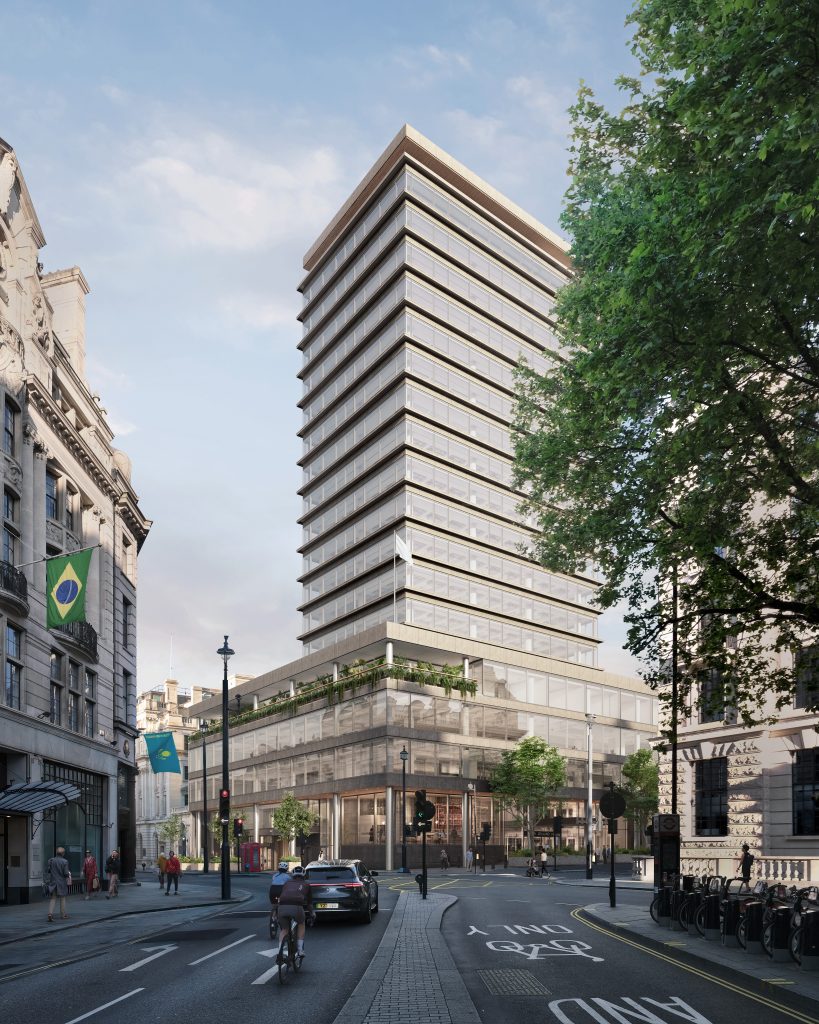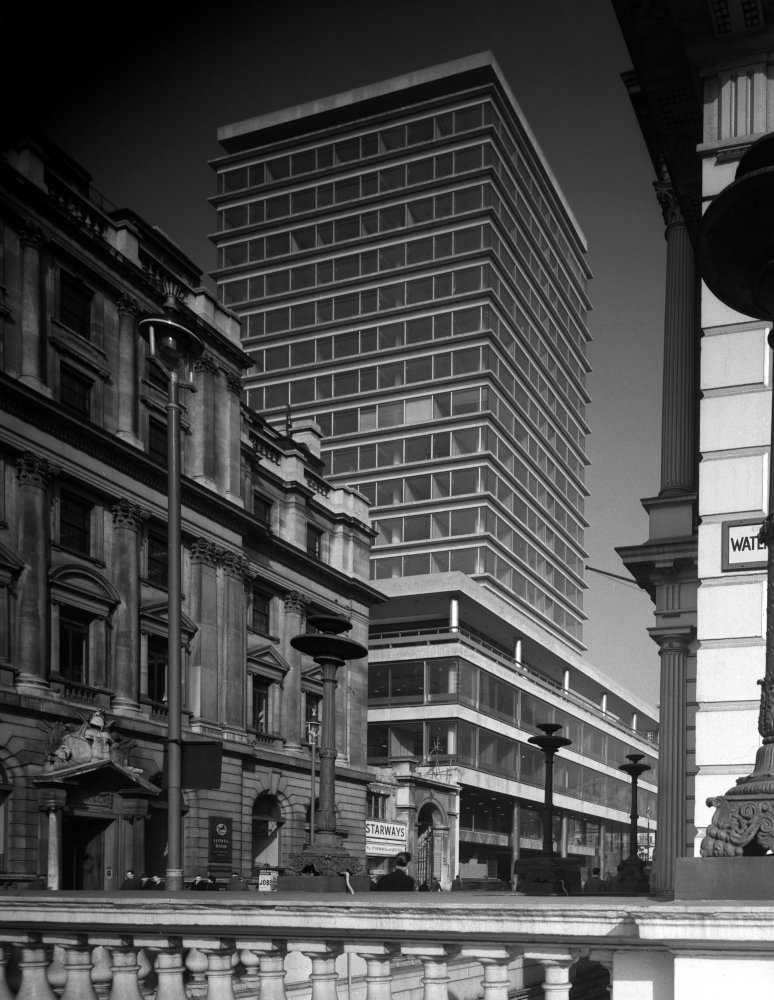The Crown Estate has unveiled details of its pipeline of developments in London’s West End. The three projects, which have a Gross Development Value of over £430 million, will deliver 251,000 sq ft of office, leisure and retail space in the heart of the Capital.
Amongst the three developments is New Zealand House – the landmark Grade II listed building at the southern gateway to Haymarket, the Arts Quarter and St James’s Market.
Opened in 1963, the modernist landmark served as a symbol of the New Zealand Government’s post-Second World War commitment to the United Kingdom, and as a home-away-from-home for New Zealanders overseas. It featured ample office space, a state to which it will return when the retrofit works are complete, with the New Zealand High Commission returning to take substantial space in the building, including in the podium and the top floors.
Its iconic mid-century architecture, designed by renowned architect Robert Matthew, Johnson Marshall & Partners, dominates the skyline in St James’s as the only building of height in the area, providing sweeping views of Westminster to the south and the wider West End to the north. As the first major office tower in London and the first to be fully glazed on all sides, its design paved the way for a broader acceptance of modernist, tall buildings.
When it was constructed, it was a shining example of innovation and modernity, boasting the first fully air-conditioned office in the Capital. It is this focus on innovation that is once again at the heart of construction works at New Zealand House. During the retrofit project, 90% of the structure is being retained and 1,600 sq m of heritage finishes are being carefully preserved, respecting the listed status of the building. The project has already seen 7,000 items collected for reuse in other projects, steel obtained from reused sources, over 1,300 sq m of marble being reused throughout and renewable energy will be purchased through a PPA from a solar farm in Norfolk to power the construction site.
One of the building’s most unique interior features is the giant Te Pouihi; an intricate and spiritually important Māori carving, which sits in the entrance of New Zealand House. Te Pouihi was created specifically for New Zealand House by Inia Te Wīata, a New Zealand Māori opera singer, master carver, film actor and artist, alongside his two sons. They carved the 50ft, two-tonne pouihi over seven years in the building’s basement carpark.
The original pouihi will maintain its position in the refurbished New Zealand House, where it embodies the enduring link between the United Kingdom and New Zealand.
The building’s iconic glazing, which provides a striking line of site through the building from St James’s to Westminster, will be replaced with an innovative alternative to improve thermal performance and passive shading, with The Crown Estate installing digital systems to accurately monitor environmental performance.
In total, the construction phase is anticipated to use less embodied carbon than The Crown Estate’s ambitious target of 400kgCO2/m2 across its development portfolio.
The works, which are already underway, also include the restoration and refurbishment of the Grade I listed Royal Opera Arcade. Designed by John Nash and George Repton and completed between 1816 and 1818, it is considered to be London’s oldest existing shopping arcade having survived a fire and the Blitz. Its vaulted roof, circular skylights and protruding quadrant-cornered shopfronts lining the passageway were influenced by Parisian arcades, whilst its overall layout and covered shopping concept paved the way for future arcades in the Capital.
Once completed, New Zealand House will deliver 138,000 sq ft of quality office and hospitality space, transforming the site and wider district once more into a thriving, progressive destination.


Clare Harrison, Development Director at The Crown Estate, said: “New Zealand House was once a beacon of modernity and innovation in London – we now have the chance to reclaim its former glory and celebrate its striking mid-century architecture.
“With the New Zealand High Commission returning to its historic home in St James’s, today’s news represents both a celebration of our shared heritage, and a positive look towards our future. Along with 10 Spring Gardens and 33-35 Piccadilly, the development of New Zealand House will provide spaces and places that work for both the needs of today and future generations.”
New Zealand High Commissioner to the United Kingdom, Phil Goff, said: “The New Zealand Government is delighted to be partnering with The Crown Estate on this project to redevelop and refine New Zealand House in its central and landmark site. When complete, the building will meet the modern needs of New Zealand government agencies in London. With the restoration of the unique Pouihi, it will continue to reflect New Zealand’s culturally rich Māori heritage.
“Redeveloping the building retains the history of the site, and through its prominence and centrality New Zealand House continues to represent the close, deep and enduring relationship between New Zealand and the United Kingdom.”
The Crown Estate has also revealed details around two other developments in its pipeline. 10 Spring Gardens – located between The Mall and Trafalgar Square – will deliver c.80,000 sq ft of sustainable workspace, distributed over ground floor, basement and eight upper storeys. This project also places a high priority on sustainable design and construction retaining over 90% of the building’s structure and façade, minimising the use of new raw materials, whilst enhancing the quality of the office floor plates, amenity spaces and entrances. Upon completion it is targeting a NABERS 5* rating, EPC A and BREEAM Excellent, as well as a WELL Gold Certification.
33-35 Piccadilly is the only new building construction project in The Crown Estate’s development pipeline. The redevelopment will provide 3,000 sq ft of prime retail and food & beverage space on the ground floor, with 30,000 sq ft of office space on the floors above. This represents an 85% increase in office and retail floor space.
The project will also provide an improved connection between St James’s Church and Swallow Street, alongside improved public realm around the building. It is targeted to achieve a NABERS 5* rating, a WELL Platinum Certification and BREEAM Outstanding.
The Crown Estate’s ambitious development pipeline will completement other major projects across its London portfolio, including the extensive improvements that will be made to public spaces across Regent Street, Haymarket and Piccadilly Circus in conjunction with Westminster City Council.
Multiplex and Lifschutz Davidson Sandilands have been appointed as construction partners and architects respectively for the New Zealand House project.
Paul Sandilands, Director at Lifschutz Davidson Sandilands said:
“When first designed, the building for the New Zealand High Commission signalled a radical shift to an architecture representative of a widespread intent to more open, transparent public administration in the post war world; literally, in part, organisationally and spatially otherwise.
“The first major works to the building in over 60 years will, with current day, agile technology (high-performance active glazing systems, sophisticated zonal environmental systems and pragmatic conservation), finally allow the architecture to manifest RMJM’s (Robert Matthew Johnson-Marshall) original vision.”


Building, Design & Construction Magazine | The Choice of Industry Professionals





